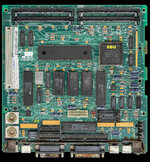What differentiates the Macintosh SE from the rest of it's forebears? Well, the fact that the PAL's of the earlier 128K, 512K & Plus machines have gone away and been replaced by a single custom ASIC.
The original Macintosh was designed around a single ASIC called the IBM or 'Integrated Burrell Machine'. It was supposed to simplify the logic and the board layout - however, this never materialised as hoped and so the team fell back on tried and tested PAL chips instead.
However the idea was never really fully dropped, and years later, Robert Leroy "Bob" Bailey created the single chip ASIC that Apple had wanted all along - calling it, the Bob Bailey Unit. It was a consolidation of the BMU's, ASG, TSM, TSG, LAG, but with a few extra's thrown in.
The video PAL's in the Plus and earlier compact Macs spend 50 percent of the RAM access time available during display of a horizontal line, leaving the other 50 percent of that time for doing everything else. The earlier Macs spend all of the time for normal computation during the vertical and horizontal retrace intervals, when the screen is not drawing anything.
However, because the BBU can transfer twice as much data at a time into the video circuitry, the Macintosh SE spends only one quarter of the RAM access time dedicated to the video display. This provides a significant performance boost over the Plus & prior compacts for running applications in RAM.
Real world tests show that this arrangement gives the SE a 10 to 20 percent performance boost over the Plus.
Did you know as well that the Macintosh Classic is essentially a cost-reduced SE? It even uses the same BBU chip there, too - so the BBU was produced from 1986 all the way to 1992. They're identical, pinout wise, even if the part numbers are obfuscated. If you have a totally dead classic, you can save the BBU and use that to build yourself a Macintosh SE Reloaded
Due to the work of @jgrip and his metallurgical microscope, a BBU was sacrified to THE GREATER GOOD and imaged. If you click on this link, you can look at the die, zoom in, scan around and see the detail of the logic gates themselves:
https://siliconpr0n.org/map/apple/344s0603-b/mz_am10x/
He's also taken the BrainStorm BBU formerly belonging to @ScutBoy and imaged that, too!
https://chips.c128.se/brainstorm/
Thanks to the imaging - if you notice in the bottom left hand corner of the die, there's a little more information. Even though the chip was diffused by IMP, in this instance, the internals are actually by VTi (later known as just VLSI), but more specifically, the VGC1900 series of off-the-shelf ASIC's.
OK, so that's cool, but why is that important?
Well, just so happens we also have the VGC1900 Series Gate Array Design Manual, here:
Using this, we can disassemble the structure of the gate, possibly using something like https://www.degate.org/ - any takers?
The original Macintosh was designed around a single ASIC called the IBM or 'Integrated Burrell Machine'. It was supposed to simplify the logic and the board layout - however, this never materialised as hoped and so the team fell back on tried and tested PAL chips instead.
However the idea was never really fully dropped, and years later, Robert Leroy "Bob" Bailey created the single chip ASIC that Apple had wanted all along - calling it, the Bob Bailey Unit. It was a consolidation of the BMU's, ASG, TSM, TSG, LAG, but with a few extra's thrown in.
The video PAL's in the Plus and earlier compact Macs spend 50 percent of the RAM access time available during display of a horizontal line, leaving the other 50 percent of that time for doing everything else. The earlier Macs spend all of the time for normal computation during the vertical and horizontal retrace intervals, when the screen is not drawing anything.
However, because the BBU can transfer twice as much data at a time into the video circuitry, the Macintosh SE spends only one quarter of the RAM access time dedicated to the video display. This provides a significant performance boost over the Plus & prior compacts for running applications in RAM.
Real world tests show that this arrangement gives the SE a 10 to 20 percent performance boost over the Plus.
Did you know as well that the Macintosh Classic is essentially a cost-reduced SE? It even uses the same BBU chip there, too - so the BBU was produced from 1986 all the way to 1992. They're identical, pinout wise, even if the part numbers are obfuscated. If you have a totally dead classic, you can save the BBU and use that to build yourself a Macintosh SE Reloaded
Due to the work of @jgrip and his metallurgical microscope, a BBU was sacrified to THE GREATER GOOD and imaged. If you click on this link, you can look at the die, zoom in, scan around and see the detail of the logic gates themselves:
https://siliconpr0n.org/map/apple/344s0603-b/mz_am10x/
He's also taken the BrainStorm BBU formerly belonging to @ScutBoy and imaged that, too!
https://chips.c128.se/brainstorm/
Thanks to the imaging - if you notice in the bottom left hand corner of the die, there's a little more information. Even though the chip was diffused by IMP, in this instance, the internals are actually by VTi (later known as just VLSI), but more specifically, the VGC1900 series of off-the-shelf ASIC's.
OK, so that's cool, but why is that important?
Well, just so happens we also have the VGC1900 Series Gate Array Design Manual, here:
Using this, we can disassemble the structure of the gate, possibly using something like https://www.degate.org/ - any takers?


